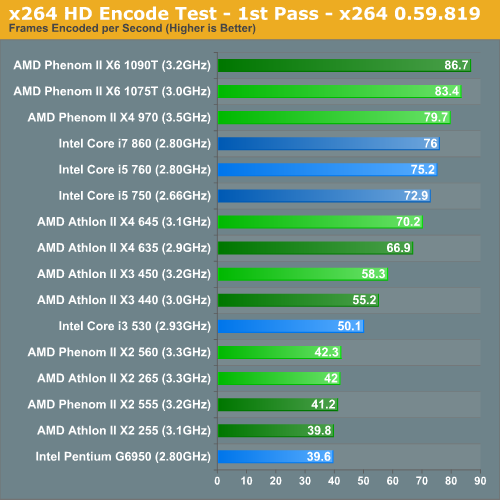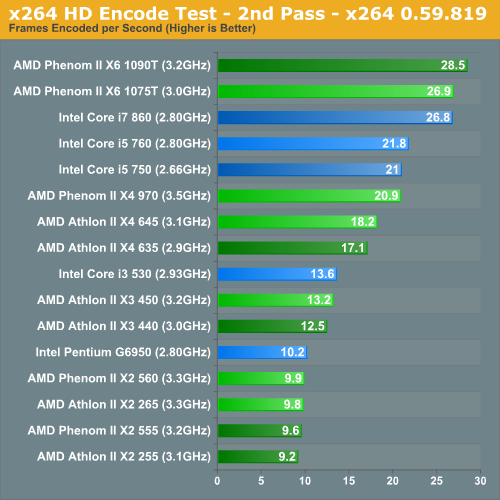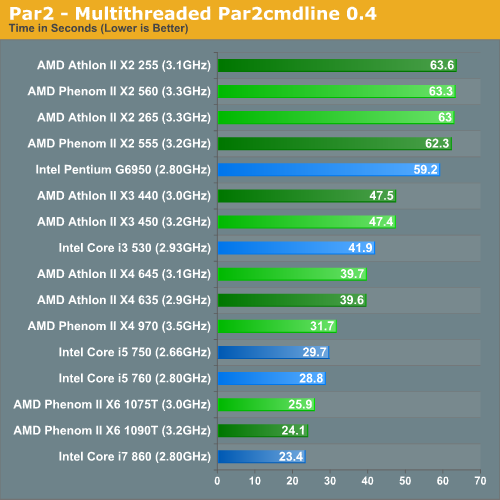AMD's Fall Refresh: New Phenom II and Athlon II CPUs Balance Price and Performance
by Anand Lal Shimpi on September 21, 2010 2:52 AM EST- Posted in
- CPUs
- AMD
- Phenom II X6
- Athlon II
x264 HD Video Encoding Performance
Graysky's x264 HD test uses x264 to encode a 4Mbps 720p MPEG-2 source. The focus here is on quality rather than speed, thus the benchmark uses a 2-pass encode and reports the average frame rate in each pass.


Video encoding performance is a definite strength of the Phenom II X6. You get comparable performance to the more expensive Core i7 860. And without Hyper Threading, the Core i5s are unable to distance themselves from the Phenom II X4 970.
Again the Athlon II X4 645 and X3 450 dominate their respective competitors.
PAR2 Multithreaded Archive Recovery Performance
Par2 is an application used for reconstructing downloaded archives. It can generate parity data from a given archive and later use it to recover the archive
Chuchusoft took the source code of par2cmdline 0.4 and parallelized it using Intel’s Threading Building Blocks 2.1. The result is a version of par2cmdline that can spawn multiple threads to repair par2 archives. For this test we took a 708MB archive, corrupted nearly 60MB of it, and used the multithreaded par2cmdline to recover it. The scores reported are the repair and recover time in seconds.

The direct comparisons we've been pointing out this entire match continue to hold as we look at different applications. The Phenom II X6 1075T performs as it should, while the Phenom II X4 970 falls short of the i5 750. The triple and quad-core Athlon IIs couldn't be better.
7-Zip Benchmark Performance
Included in 7-zip is a pure algorithm test that completely removes IO from the equation. This test scales with core count and as a result we get a good theoretical picture of how these chips perform. Note that the actual 7-zip compression/decompression process is limited to 2 threads so there's no real world advantage to having more cores.











98 Comments
View All Comments
Stuka87 - Tuesday, September 21, 2010 - link
I would really like to see a "Bang for your Buck" graph. In many test, AMD comes close to the i7, but the i7 cost more. So when you do a performance per dollar ratio, AMD may come out on par, or maybe even ahead in some cases.I also find it interesting that some of the Phenom II x4's have a lower power consumption at idle than the X2's. I realize the X2's use the same silicon, but with the cores turned off, shouldn't they use less?
Great over all article as always though :)
Zanfib - Tuesday, September 21, 2010 - link
Anand, as always great work,You write "Bulldozer is out of the question however, AM3+ chips aren’t backwards compatible with AM3 motherboards (although the opposite is true, you will be able to use your 970 in an AM3+ motherboard)."
Is this the definitive truth? :-)
I have read a lot of people guessing whether AMD will have AM3 compatibile Bulldozer modes available, or only AM3+ (AM3Rev...).
Thanks!
Anand Lal Shimpi - Tuesday, September 21, 2010 - link
This information came directly from AMD :) Not saying it's 100%, just saying it's the source.You'll see AM3+ motherboards in advance of the Bulldozer client launch so you'll be able to buy a new board for your CPU and then later drop in a Bulldozer.
Take care,
Anand
stmok - Tuesday, September 21, 2010 - link
Yeah, its true.Bulldozer isn't backward compatible with current Socket AM3 motherboards.
But Socket AM3+ motherboards will be backward compatible with existing AM3 processors.
Mentioned on a number of sites...
=> http://www.extremetech.com/article2/0,2845,2368186...
"AMD also told us that it will introduce a new AM3+ socket for consumer versions of Bulldozer CPUs. AM2 and AM3 processors will work in the AM3+ socket, but Bulldozer chips will not work in non-AM3+ motherboards."
=> http://www.rage3d.com/articles/amd_heat_vision_hot...
"For the desktop, the Zambezi processor is good news and bad news. The good news is it's an 8 core product, the bad news is it needs a new socket - AM3r, or AM3+. This is an electrical upgrade of the AM3 platform, to provide the power phases and planes/states required by the power gating features of Zambezi. As you might have guessed from the name, this socket is backwards compatible with existing AM3 processors, so you'll be able to piecemeal your upgrade - motherboard for your birthday, CPU for Christmas, or however your upgrade cycle works."
=> http://www.xtremesystems.org/forums/showpost.php?p...
"When we initially set out on the path to Bulldozer we were hoping for AM3 compatibility, but further along the process we realized that we had a choice to make based on some of the features that we wanted to bring with Bulldozer. We could either provide AM3 support and lose some of the capabilities of the new Bulldozer architecture or, we could choose the AM3+ socket which would allow the Bulldozer-base Zambezi to have greater performance and capability.
The majority of the computer buying public will not upgrade their processors, but enthusiasts do. When we did the analysis it was clear that the customers who were most likely to upgrade an AM3 motherboard to a Bulldozer would want the features and capability that would only be delivered in the new AM3+ sockets. A classic Catch-22.
Why not do both you ask? Just make a second model that only works in AM3? First, because that would greatly increase the cost and infrastructure of bringing the product to market, which would drive up the cost of the product (for both AMD and its partners). Secondly, adding an additional product would double the time involved in many of the development steps.
So in the end, delivering an AM3 capability would bring you a less featured product that was more expensive and later to market. Instead we chose the path of the AM3+ socket, which is a path that we hope will bring you a better priced product, with greater performance and more features - on time.
When we looked at the market for AM3 upgrades, it was clear that the folks most interested in an AM3-based product were the enthusiasts. This is one set of customers that we know are not willing to settle for second best when it comes to performance, so we definitely needed to ensure that our new architecture would meet their demanding needs, for both high performance and overclockability. We believe they will see that in AM3+."
Taft12 - Tuesday, September 21, 2010 - link
<i>But Socket AM3+ motherboards will be backward compatible with existing AM3 processors.</i>This was not true from AM2+ to AM3, and I don't believe for a second this is true across the board from AM3 to AM3+. Many motherboard manufacturers (even top tier ones) will not bother with BIOS updates to older boards that went EOL some time ago.
If your board has a 7xx or Nvidia chipset and has been EOL for a year, I wouldn't count on anything. Better safe than sorry.
JMC2000 - Tuesday, September 21, 2010 - link
"This was not true from AM2+ to AM3, and I don't believe for a second this is true across the board from AM3 to AM3+. Many motherboard manufacturers (even top tier ones) will not bother with BIOS updates to older boards that went EOL some time ago."From what I read, it is not the same situation before: Most AM2+ boards can run AM3 cpus, pending on BIOS support, AM2+ cpus will not work on AM3 boards, because they do not have a DDR3 memory controller. AM3+ (AM3r2) cpus will not work on AM3 boards, because the power gating logic on Bulldozer based cpus is not compatible with the power plane setup on AM3.
Basically, AM3 cpus are both backwards and forwards compatible with previous and upcoming sockets in their line.
Dark_Archonis - Tuesday, September 21, 2010 - link
Yes, for AMD owners, the party is over. Bulldozer is not compatible with AM3 motherboards, so anyone who wants Bulldozer will need a new motherboard.Madmanden - Wednesday, September 22, 2010 - link
The party's over for both AMD and Intel users. They both have to get a new board for upcoming CPUs.mike23 - Thursday, September 23, 2010 - link
this is a very good point.Benchmarks that cover something more than common tasks (that low and mid range processors do adequately every day) would be helpful.
With regard to the competition issue...It's blatantly obvious where Intel sees AMD as competition. All the way up to the 4 core I7 series. Beyond that, no competition and ridiculous prices.
If not for AMD's efforts, you wouldn't have the I5's and I7s in the 200-300+ range right now. So, yes, they are providing strong competition in certain market segments.
DMisner - Tuesday, September 21, 2010 - link
Would you consider doing something of a Folding@Home benchmark, possibly running the SMP client for a day or something and seeing what kind of PPD figures you would get with these processors?Seems like F@H is really what I do most with my computers.